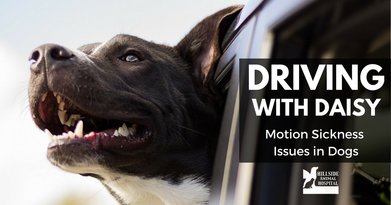Spring is on the way. After a long winter, we all want to get out and enjoy the warmer weather. For many of us, that means we are starting to think about our travel plans. When making arrangements, do you find yourself not including your dog because he or she has a difficult time with car rides? Does your dog simply not like traveling? Does he or she become physically ill? Imagine being able to share more experiences with you canine friend without the stress.
Car rides can be an overwhelming experience for dogs. The smells, sounds, and movement can create a perfect storm of sensory overload. These can all lead to motion sickness, a common affliction in our canine friends. Studies have shown that 1 in 5 dogs suffer from this ailment. Unfortunately, most pet owners do not recognize the signs. Do you know what to look for? It can be present in a variety of ways in dogs. The most common physical signs to look for are drooling, heavy panting, excessive lip licking, vomiting, pacing, shaking, and whining (visit cerenia.com for a comprehensive list of symptoms). Luckily there is something that can help alleviate their discomfort. It is the first and only FDA-approved medication to prevent vomiting due to motion sickness. Studies show it is successful in up to 93% of dogs. Call your veterinarian to talk about your dog’s symptoms to see if he or she would benefit from the medication.
Many dogs do not display physical signs of motion sickness, however, they simply do not like car rides. In these cases, treating the behavioral aversion to the experience can be beneficial. The process will require some patience but will be helpful in the long run. To do this you first need to make positive associations with the car. This is known as counter-conditioning. Some people will feed their dog in or near the car, or play with their favorite toys around the vehicle. Every time they approach the car or jump in willingly, you should reward that behavior with treats or praise. Once they are comfortable hopping into the car, go for very short rides. In some cases, simply backing the car down the driveway, or just a short ride around the block is all you need to do. The goal is to get them acclimated to the process. Sometimes playing soothing music in the car and talking in calm, reassuring tones will be helpful as well. Many people have had success with the assistance of the Adaptil spray, a pheromone that has proven to help ease anxiety in dogs. A Thundershirt can also assist in reducing their anxiety in multiple situations. Make sure it is always a positive experience. If your dog appears anxious, discontinue for the day and start at the beginning the next time. Slowly build on the length of time spent in the car until you are able to drive long distances with no signs of stress.
Now that your dog is more comfortable in the car, you can start planning a fun outing. Before leaving, it is always a good idea to do a little research. Look up the route you are planning to take to be sure there are plenty of rest stops you can make with your dog. Also, make sure you find pet-friendly hotels and restaurants along the way. In some cases, a health certificate issued by your veterinarian is required for travel. In order to obtain this document, your pet will need to be examined by your veterinarian, be current on all vaccines, and be in good health. It is always a good idea to bring your pet’s veterinary records and a picture of them with you in case of an emergency, especially if they have a specific medical issue. If your pet is on medications, make sure you have enough for the trip as well as a little extra in case your plans change.
Traveling with your dog doesn’t have to be an ordeal. Call us at Hillside Animal Hospital today and together we can come up with a plan to make the ride more enjoyable for everyone. Safe travels!
–Carolyn, RVT

